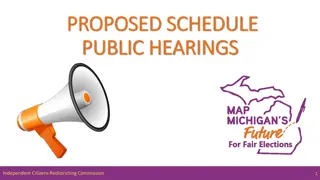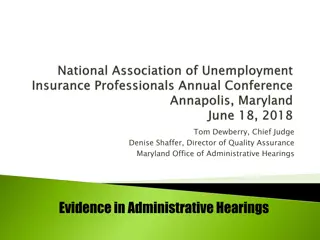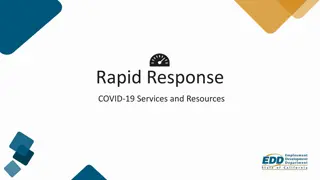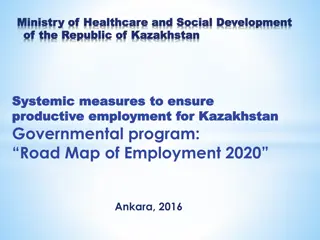Understanding Credibility in Unemployment Hearings
Exploring the importance of credibility in lower authority unemployment insurance hearings and how decisions are made. Learn about the significance of credibility findings, the impact on payment accuracy, statutory requirements, process of making credibility determinations, and key elements considered.
Download Presentation

Please find below an Image/Link to download the presentation.
The content on the website is provided AS IS for your information and personal use only. It may not be sold, licensed, or shared on other websites without obtaining consent from the author. Download presentation by click this link. If you encounter any issues during the download, it is possible that the publisher has removed the file from their server.
E N D
Presentation Transcript
Truth or Fiction? Finding Credibility in Lower Authority Unemployment Insurance Hearings Katrina Gulstad Chief Unemployment Law Judge Sasha Mackin Supervising Unemployment Law Judge Seattle, Washington June 21, 2017
Truth or Fiction credibility determinations in unemployment benefits hearings Why do we care about credibility findings? How do we make credibility findings? How do we articulate credibility findings?
Why we care UI Program supposed to pay those eligible and not pay those ineligible. Legitimacy of the decision how did the hearing officer arrive at this decision? Is it arbitrary? Biased? Is it mandatory in your state to make a credibility finding?
Pay the right people the right amount From 4th quarter 2015 to 3rd quarter 2016, USDOL estimates the total improper payment amount to be a whopping $3,644,518,239. That s an average rate of 12.08% across all state programs.
Minnesotas statutory requirement Minnesota Statutes, section 268.105, subd. 1a: When the credibility of a witness testifying in a hearing has a significant effect on the outcome of a decision, the unemployment law judge must set out the reason for crediting or discrediting that testimony.
How do we make credibility findings? What process do you go through to assess credibility? What do you look at?
Elements of Credibility Level of details Consistency Plausibility Story make sense? Self-serving Corroboration Body language Tone of voice Eye contact Ability to recall facts Opportunity to know the facts Evasive Nonresponsive Answers that go to emotion and not fact Hearsay
Barriers to assessing credibility Partial truth-tellers Equally plausible/implausible versions Is there a statutory default? Burden of proof? Interpreters Absence of information Time Telephone hearings
Barriers to assessing credibility Partial truth-tellers Equally plausible/implausible versions Is there a statutory default? Burden of proof? Interpreters Absence of information Time Telephone hearings Implicit Bias Prejudging the case based on fact finding
Migrant farm worker case The migrant workers stories were inconsistent and in some cases, fabricated. Vs. The employer witness had detailed testimony, claimed to have detailed business records, emphatic, better recall, consistent within each hearing, more sophisticated witness; knew the law.
How to articulate credibility Avoid canned language. Use examples from the hearing. Be respectful in your tone don t resort to sarcasm or snark. Write down what you re thinking as you decide which version of events you conclude is true.
Written credibility findings Okay: The findings of fact are based on the employer's witnesses' testimony, because it was a more detailed and specific version of events.
Written credibility findings Better: The findings of fact are based on the testimony of the employer's witnesses which was detailed and specific. Smith's assertion that she was unfairly targeted is implausible; an employee who is specifically targeted for discharge is unlikely to be allowed to work for over a year after repeatedly violating a known policy. Also, Smith's initial statements to the Department, that she did not know why she was discharged, were disingenuous. It is not believable that an employee who repeatedly violates a policy after a written warning would have no inkling of the reasons for her discharge.
Written credibility findings Okay: The findings of fact are based on the employer's witnesses' testimony, because it was a more credible and straightforward version of events.
Better: To the extent the parties disagreed, the findings of fact are based on the employer's witnesses' testimony, which was more credible because it was straightforward and more reasonable under the circumstances. Smith's testimony was, at times, implausible and unreasonable under the circumstances. Smith testified that on occasions she accessed Facebook, she was entitled to take breaks and to do what she pleased during her breaks. Smith clocked in at 7:28 a.m. on March 22, and was active on Facebook at 7:43 a.m., 7:47 a.m., 8:52 a.m., and 8:57 a.m. Smith claimed that she was on break at those times. It is not believable that Smith really thought that it was reasonable to take a break 13 minutes after the start of her shift, and then to take another break just over an hour later. Smith was either accessing Facebook outside of her permissible break time, or she was taking unreasonable and excessive breaks.
Written Credibility Findings Okay: Smith was more credible than the employer because he provided a more logical version of events.
Written credibility findings Better: Smith was more credible than the employer s witness because he offered a more logical chain of events that was corroborated by written submissions. Smith was an eyewitness while the employer s witness provided only hearsay testimony. The employer s witness testified to conclusions and not detail. Smith recalled the facts easily and admitted to some actions that did not paint him in the best light.























